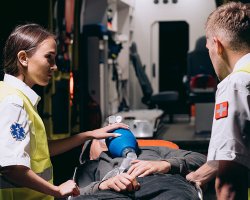Why Does the U.S. Prescribe More Drugs than Other Countries?

A striking report from U.S. News revealed that American surgical patients are nine times more likely to receive a prescription for opioid pain relievers than Swedish patients. Even bringing the focus closer to home and comparing U.S. prescribing rates to Canadian prescribing rates, American doctors still prescribe opioids at a rate nearly twice that of Canadian doctors.
Why is the U.S. still prescribing opioid pain relievers at rates far higher than other countries? And why especially is this continuing when it is painfully clear how dangerous these drugs are? Why is the U.S. prescribing even more potent drugs than other countries?
The United States, Sweden, Britain, and Canada
The U.S. News article reported on research performed by the Penn Medicine Opioid Task Force in Philadelphia. The researchers found that, within 30 days of leaving a hospital after surgery, nearly half of U.S. patients had been prescribed high doses of potentially addictive and dangerous opioid pain relievers. That’s double the Canadian prescribing rate post-surgery (25 percent of patients). And it’s nine times greater than the Swedish prescribing rate post-surgery (5 percent of patients).
The researchers examined cases involving 220,000 patients, all of whom received surgical procedures for similar medical conditions. The researchers noted that American patients were not only more likely to receive opioid prescriptions and to fill those prescriptions, but that they were also more likely to receive higher dosages of opiate pain meds than Swedish patients. And within just one week after discharge, some 75% of American patients filled a prescription for an opioid painkiller. Compare that to Swedish patients, where only 11% of the Swedes fill an opioid prescription after a hospital stay.
Dr. Yili Huang is the director of the pain management center at Phelps Hospital in Sleepy Hollow, N.Y. He commented on the study, noting that the reason why American prescribers turn to higher-strength opioids likely has nothing to do with a health-based incentive. Instead, the reasoning comes from Big Pharma’s influence on the medical field.
U.S. News cited the following quote from Dr. Huang: “Pharmaceutical marketing may have been a major driver. Unsurprising that patients in Sweden are less likely to receive opioid medications after surgery since Nordic countries have historically had stringent pharmaceutical marketing regulations that limit marketing directly to doctors.”
Britain also has a drastically different approach to opioid prescribing than the U.S. does. A clear indicator of this is present when we compare U.S. dental opioid prescribing and British dental opioid prescribing.
Quoting a study published in the Journal of the American Medical Administration: “In 2016, the proportion of prescriptions written by U.S. dentists that were for opioids was 37 times greater than the proportion written by English dentists. In all, 22.3% of U.S. dental prescriptions were opioids (11.4 million prescriptions) compared with 0.6% of English dental prescriptions (28,082 prescriptions).”
It is more than clear how damaging and harmful prescription opioids can be. But do countries like Canada, Britain, and Sweden have it all figured out?
The Downside of Not Prescribing Pain Relievers

We do have to look at both sides of the coin. One of the downsides to how other countries approach pain symptoms is that they often don’t approach it. Yes, these countries have remarkably lower opioid prescribing rates than the United States. However, thousands of residents of these countries live with untreated pain symptoms.
Quoting an epidemiology study of chronic pain in Denmark and Sweden, “In both Denmark and Sweden, chronic pain is a common health problem which is potentially under-treated and warrants the attention of health care workers, policymakers, and researchers.”
Keeping opioid prescribing rates at an absolute minimum is the correct approach to take, given how risky these drugs are. However, that only works when medical practitioners also then offer alternatives in pain relief. We cannot drastically reduce opioid prescribing and then not provide alternative pain relief solutions. Millions of Americans struggle with chronic and acute pain symptoms. They need effective and low-risk, addiction-free solutions.
Our doctors need to offer non-addictive options in pain relief. Such options do exist. Chiropractic care has been known to relieve pain, according to the Harvard Medical School. Furthermore, there is a long list of natural supplements, remedies, and holistic medicines that have the stamp of approval from the Arthritis Foundation for being viable in pain relief. And last but not least, an over-the-counter pain medication that is not opioid-based is often more than sufficient for countering everyday aches and pains, according to the American Society of Anesthesiologists.
Helping a Loved One Break Free from a Prescription Opioid Addiction
According to the National Survey on Drug Use and Health, “In 2017, approximately 19.7 million people aged 12 or older had a substance use disorder (SUD) related to their use of alcohol or illicit drugs in the past year, including 14.5 million people who had an alcohol use disorder and 7.5 million people who had an illicit drug use disorder. The most common illicit drug use disorder was for marijuana (4.1 million people). … An estimated 2.1 million people had an opioid use disorder, which includes 1.7 million people with a prescription pain reliever use disorder, and 0.7 million people with a heroin use disorder.”
Rewind the clock 20 years, and no one would ever have imagined that our country stood on the precipice of such an addiction epidemic like this. No one would have guessed that, by 2017, almost two million Americans would be addicted to opioid prescription pain relievers. Now that we know how dangerous these drugs are, we need to take bold action to reduce our country’s prescribing rate.
But if you have a family member or loved one who is currently addicted to opioid pain relievers, your efforts to help reduce prescribing rates in your community or state will not do much for your loved one. Instead, you need to focus on getting your loved one help at a qualified drug and alcohol addiction treatment center.
The only way for those who currently struggle with opioid addiction to break free from their habits is by entering into a residential drug and alcohol addiction treatment center. Residential rehab programs offer the safest and most reliable approach to helping people break free from addiction. If your loved one is hooked on opioids, do you best to get them into a residential program today.
Sources:
- https://www.usnews.com/news/health-news/articles/2019-09-04/us-opioid-prescription-rate-is-7-times-that-of-sweden
- https://jamanetwork.com/journals/jamanetworkopen/fullarticle/2734067
- https://www.hindawi.com/journals/prt/2012/371248/
- https://www.health.harvard.edu/pain/chiropractic-care-for-pain-relief
- https://www.arthritis.org/living-with-arthritis/treatments/natural/supplements-herbs/9-supplements-arthritis.php
- https://www.asahq.org/whensecondscount/pain-management/non-opioid-treatment/
- https://www.samhsa.gov/data/report/2017-nsduh-annual-national-report


 ®
®